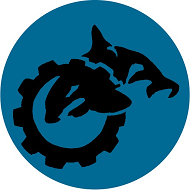Embarrassing, but this is one of the places we were lucky and not good, so we thought we would post about it in case it helped anyone in their designs. The initial designs for what evolved into the Blacktip drone had a dry internal cavity. Since a dry chamber requires that the entire chamber be …
Category Archives: Blacktip
Blacktip – Float test passed
The earlier float tests have all been for either parts of the Blacktip hull individually, or of the hull with only some of the internal and external hardware bolted into the hull. Today’s float test was for the entire hull – with everything but the electronics part of the ballast control system in place. Both …
Welcome to the drone factory!
One of the major research questions we have been working on for nearly two years, is figuring out how to bring down the cost of drone production; both the labor and components costs. While we still have a lot farther to learn, some time in the last few months we crossed a major milestone without …
3D Printed Hull Failure
Based on our research at Rumblefish, it is clear that 3D printing to drone hull construction has tremendous potential. That said – there is a lot we have had to learn, and most of those lessons were gifted from unexpected failures. This hull crack is perhaps the biggest failure so far, and it was totally unexpected. …
Float test in a bathtub?
One of the design constraints placed on hull design was the maximum core hull length. While shipping options drove this design constraint, it meant that the core hull could be periodically float tested, and its true vs. calculated displacement checked, in a bathtub. Here you can see our first float tests of the core blacktip …
Hull Painting
Two of the open questions in our research on 3D printed drone hulls were how to waterproof them, and how to get them to be hydro-dynamically smooth. While solvent fuming techniques do address both problems – there were a lot of drawbacks those techniques were not used in creating our larger hulls. In the end, …
Printing A Hull – the halfway point!
The current Blacktip hull was designed to be printed in sections. The thinking was that a multi-part design could have the pieces printed in parallel, greatly speeding up the time to create a custom hull. As a result, the current hull design consists of 12 large sections. A large format, heavily modified, delta 3D printer was …
Researching cast epoxy hulls
Hulls cast from epoxy are ideal for bio-inspired robotics. Casting an epoxy hull into 3D printed disolvable molds enables fast creation and iteration on incredibly comlex hull designs, even those containing the complex organic found in bio-inspired designs. Casting also enables simple embedded inclusions enable features such as threaded bolts extruding from the cast hull, …
Blacktip – Initial hull design
Hull hydrodynamics is a critical design constrains for autonomous craft, become exponentially more important with the intended mission duration. One of the most interesting ways to tackle this problem is to borrow from nature, which has elegantly solved the hydrodynamics problem over and over again in a variety of ways. After a number of computer …
